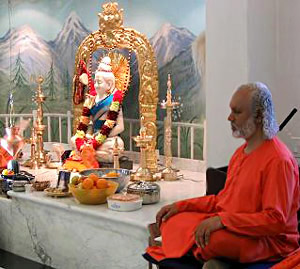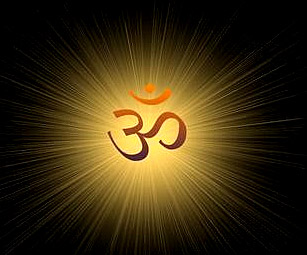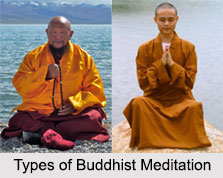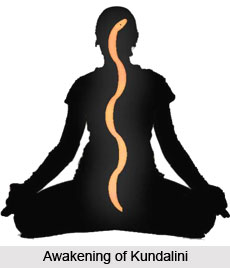"In the beginning was the Word, and the Word was with God, and the Word was God."
Sound has an immense power. In fact the power of sound is so n fact it has the power to create an entire universe. It is written that God originally manifested as sound. In ancient India it was believed that it was only sound which existed in the beginning and it was only the sound which reverberated as "Om" and from that very sound, `Om` the whole world land indeed all the living objects came into being.
Mantra in a broader sense is intrinsically related to sound. Mantra is sound, and sound reverberates in everything present in the universe. When the cascade flows, the bubbling sound it makes, is mantra, even mantra is there in the rustling sound of the falling leaves. According to the ancient Indian belief within human beings there is a self-born sound which recurrently repeats itself amidst the rhythm of human breaths and this sound is also a mantra.
Mantras are an indispensable part of any form of meditation. The words, phrases, or syllables, which are chanted thoughtfully and with growing attention, are the Mantrams. Chanting mantras in meditation necessarily involves chanting a word or phrase until the mind and emotions go beyond the conscience and become super-conscious. Since the mind wanders too much, the musical trait of a mantra easily rescues the mind and brings it back to the object of one`s meditation. Both the rhythm of mantram and the meaning of it combine to guide the mind safely to the point of meditation.
Mantrams can excite the emotions, offer suggestions to the mind, and affect both the one who chants them as the one who hears them. The word mantram comes from the Sanskrit "mantrana", which means advice or suggestion. Each mantram or word is a sound pattern that suggests to the mind the meanings innate in it, and the mind immediately responds.
 The mantra yoga involves chanting of mantra loud at first until the body is calm and the atmosphere around oneself is serene and pleasant for meditation. Then whisper meditation almost automatically occurs and the life force begins to withdraw inward from "out-loud" chanting to whisper chanting. While whisper chanting, the prana or the life force in the body, is balanced and harmonized, preparing the way for a deeper state of serenity and of the balance of mind and emotions. Whisper chanting easily liquefies and the life force moves even deeper within the chanter, as he enters mental chanting. The mantram is simply chanted in the same area of the mind that the distraction is occurring.
The mantra yoga involves chanting of mantra loud at first until the body is calm and the atmosphere around oneself is serene and pleasant for meditation. Then whisper meditation almost automatically occurs and the life force begins to withdraw inward from "out-loud" chanting to whisper chanting. While whisper chanting, the prana or the life force in the body, is balanced and harmonized, preparing the way for a deeper state of serenity and of the balance of mind and emotions. Whisper chanting easily liquefies and the life force moves even deeper within the chanter, as he enters mental chanting. The mantram is simply chanted in the same area of the mind that the distraction is occurring.
When the mind absorbs into a mantram, effortless mental chanting can be done. This may dissolve a person into super-consciousness, or it may first help ventilate the subconscious mind, the storage house of old thoughts, feelings, and memories which have been neglected. The mantram may create an opportunity for these old thoughts to be released. Finally, the chanter arrives in his ecstatic, heavenly nature through the mantram. The words of the mantram eventually fall apart and fall away. Only the energy surge of the mantram remains as the awareness and becomes blissful and full of light.
The place from which the sound of mantram emanates, influences its` tonal quality. The vocal chords in conjunction with the abdominal region, middle tones in conjunction with the chest, heart and throat regions and high-pitched tones in conjunction with the upper region of the body produce deep tones. Indian classical music uses all three regions in a continuing order, but the middle region is used most and produces a greater emotional impact on the listeners through mantrams.
Primarily it is faith, which creates the effect of mantrams. Melody, intonation, pronunciation, whether silently or aloud is important factors for the effectiveness in the recitation of mantram. Moreover, the beat cycle in which mantrams are recited is also important, but it alters according to the state of consciousness of the one who is chanting. An increase in the speed of chanting increases the speed of heartbeat, mind, and respiration. The beat cycle of the mantrams affects the emotions.
Repetition of mantrams with attention as directed to the source of the sound, completely engages the mind. This is the stage of Tapas or penance. The source is not in the vocal chords alone, but also the inspiration of the sound is in the mind, whose source is self. Thus the practice of mantram repetition is more than just a suggestion, a bit of advice or an idea. Mantrams may be used for religious worship, for purification, for japa (repetition), for healing, to help spiritual evolution, for making offerings and in Mantra Yoga. Some mantrams are only chants or expressions of nearness to the Divine. But some saints who were inspired by divine love and resolute faith used these mantrams in their own spiritual practice and their followers afterwards started using those mantrams, calling them mahamantras or great mantras.
 The most common mantram is Aum (Om), meaning Spirit or the Word of God, which creates, preserves, and transforms. This is the most profound, yet simple mantram made up three and a half syllables. The syllable `A` is the first aspect indicating the waking state, vaiswaanara. In this state, consciousness is transformed to the external. With its seven instrument and nineteen channnels, it experiences the gross phenomenal world. The second syllable `U` is the dreaming state, taijasa. In this state consciousness is turned inward and the last syllable `M` is deep sleep, prajna. In this state, there is neither desire nor dream. In deep sleep all experiences combine into the unity of undifferentiated consciousness. The sleeper is filled with ecstasy and experiences bliss and can find the way to knowledge of the two preceding states.
The most common mantram is Aum (Om), meaning Spirit or the Word of God, which creates, preserves, and transforms. This is the most profound, yet simple mantram made up three and a half syllables. The syllable `A` is the first aspect indicating the waking state, vaiswaanara. In this state, consciousness is transformed to the external. With its seven instrument and nineteen channnels, it experiences the gross phenomenal world. The second syllable `U` is the dreaming state, taijasa. In this state consciousness is turned inward and the last syllable `M` is deep sleep, prajna. In this state, there is neither desire nor dream. In deep sleep all experiences combine into the unity of undifferentiated consciousness. The sleeper is filled with ecstasy and experiences bliss and can find the way to knowledge of the two preceding states.
Another mantram is the Himalayan Shaivaist mantram: Aum Namah Shivaya, which is translated as "Om Homage to the Highest Lord God". The Hindu mantram, Asato Ma Sat Gamaya means "Lead me from the unreal to the Real." There are thousands of Veda mantrams that are mainly derived from the ancient Sanskrit language. Possibly, with time, well-known Sanskrit mantrams will be translated in English. All mantrams are the result of a revelation, usually to some deeply meditating proficient. Mantrams are always in Sanskrit, which is the divine language of Gods, Devas descended into Earth externally or inwardly as Avataras Incarnation.
Mantra in meditation helps in completely transforming the inner being. The inner state is created by the thoughts and feelings that continuously arise in the individuals. The inner self is an ever-changing mass of consciousness and whenever one project the beam of mantra into this fluctuating mass, it stabilizes it and focuses it in one direction, the direction of the self. It helps one to transcend one`s fantasies, confusion whilst stabilizing the constant changes of the mind.




















